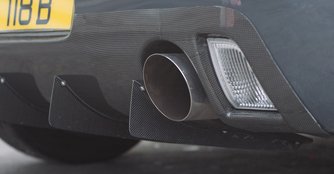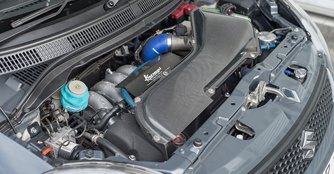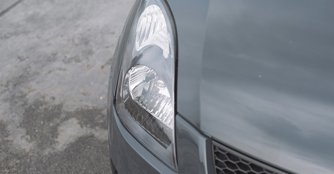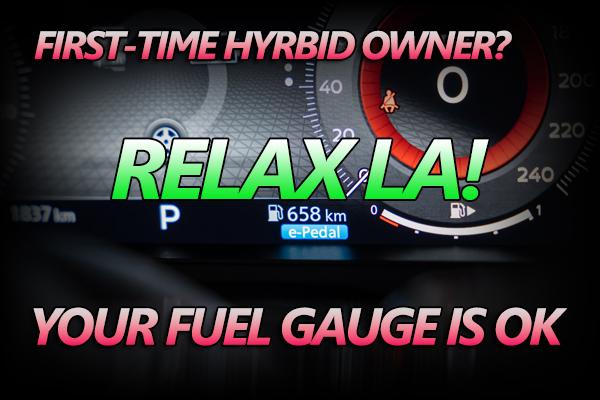Five car modification regulations that are a pain in Singapore
14 Jun 2016|19,715 views
Fashionistas decorate themselves in the latest trends to make a statement and couples design houses to turn them into homely spaces. Similarly, us petrolheads personalise or modify our cars, in respect of form and function, to suit our driving styles and tastes.
However, it isn't a secret that the general public is intolerant towards our love for cars. Whether it's fixing a performance exhaust system for improved flow, lowering your car's height for improved traction and handling, or planting a 'wing' for more downforce, non-car people are quick to judge you as a boy racer who's about to drive dangerously and cause a ruckus on the roads.
In the eyes of the intolerant and draconian Land Transport Authority (LTA), we're a bunch of criminal cash cows. While it's understandable that a car, when modified improperly, does pose a risk to the driver and other roads users, most of the regulations against car modification are biased, unfounded and, honestly, quite a pain.
Here are five of some.
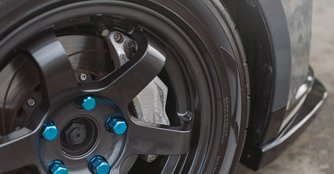
 Aftermarket brake kits tend to be a bit of a grey area as some cars have failed inspection with them installed
Aftermarket brake kits tend to be a bit of a grey area as some cars have failed inspection with them installed
Exhaust systems
Modifications to the exhaust system require LTA's approval. You have to produce certification from the product manufacturer stating that the proposed performance exhaust is suitable for the make and model of the vehicle, and have your car inspected to ensure the exhaust complies with prevailing noise and emission standards.
Turbochargers and superchargers
Turbochargers and superchargers increase the power output of your car. Many performance manufacturers create bolt-on turbocharger and supercharger kits for this purpose.
However, it isn't a secret that the general public is intolerant towards our love for cars. Whether it's fixing a performance exhaust system for improved flow, lowering your car's height for improved traction and handling, or planting a 'wing' for more downforce, non-car people are quick to judge you as a boy racer who's about to drive dangerously and cause a ruckus on the roads.
In the eyes of the intolerant and draconian Land Transport Authority (LTA), we're a bunch of criminal cash cows. While it's understandable that a car, when modified improperly, does pose a risk to the driver and other roads users, most of the regulations against car modification are biased, unfounded and, honestly, quite a pain.
Here are five of some.

Exhaust systems
Modifications to the exhaust system require LTA's approval. You have to produce certification from the product manufacturer stating that the proposed performance exhaust is suitable for the make and model of the vehicle, and have your car inspected to ensure the exhaust complies with prevailing noise and emission standards.
Turbochargers and superchargers
Turbochargers and superchargers increase the power output of your car. Many performance manufacturers create bolt-on turbocharger and supercharger kits for this purpose.
In many other countries, turbocharging or supercharging a naturally aspirated car is common. Here, turbocharger or supercharger mods as far as we know, are a huge no-no - even the upgrading or upsizing of your existing turbo or supercharger.
Increasing engine capacity
When done properly - either by boring, stroking or changing your engine block - increasing your engine's capacity is increasing the displacement and the power of the engine. For example, Civic Type R's running a 2.4-litre setup, as opposed to the original 2.0-litre K20A. After all, there's no replacement for displacement. But as doing so is considered 'cheating' of road taxes, increasing the capacity of your engine isn't allowed by LTA either.
Aftermarket lights and lamps
Swopping out my factory head or tail lamps for a set of aftermarket ones isn't my cup of tea but a favourite amongst many drivers here. Even a proper HID projector setup, which provides a stronger and more focused light beam isn't legal if it's not from the factory. However, HID kits fixed onto regular lamps, which cause an unwanted light glare aren't legal for all the right reasons.
Tinting
In the insane heat we face on a daily basis, being able to drive with slightly more tinted windows goes a long way. Tinted windows help lower the temperature of the cabin, protect you from the sun's rays, deters thieves from peering into your car and prolongs the interior. Although LTA does allow a slight amount of tinting, the opacity for the front windscreen and two front side windows must be at least 70 percent, which really doesn't help much in our climate.
Increasing engine capacity
When done properly - either by boring, stroking or changing your engine block - increasing your engine's capacity is increasing the displacement and the power of the engine. For example, Civic Type R's running a 2.4-litre setup, as opposed to the original 2.0-litre K20A. After all, there's no replacement for displacement. But as doing so is considered 'cheating' of road taxes, increasing the capacity of your engine isn't allowed by LTA either.
Aftermarket lights and lamps
Swopping out my factory head or tail lamps for a set of aftermarket ones isn't my cup of tea but a favourite amongst many drivers here. Even a proper HID projector setup, which provides a stronger and more focused light beam isn't legal if it's not from the factory. However, HID kits fixed onto regular lamps, which cause an unwanted light glare aren't legal for all the right reasons.
Tinting
In the insane heat we face on a daily basis, being able to drive with slightly more tinted windows goes a long way. Tinted windows help lower the temperature of the cabin, protect you from the sun's rays, deters thieves from peering into your car and prolongs the interior. Although LTA does allow a slight amount of tinting, the opacity for the front windscreen and two front side windows must be at least 70 percent, which really doesn't help much in our climate.
Fashionistas decorate themselves in the latest trends to make a statement and couples design houses to turn them into homely spaces. Similarly, us petrolheads personalise or modify our cars, in respect of form and function, to suit our driving styles and tastes.
However, it isn't a secret that the general public is intolerant towards our love for cars. Whether it's fixing a performance exhaust system for improved flow, lowering your car's height for improved traction and handling, or planting a 'wing' for more downforce, non-car people are quick to judge you as a boy racer who's about to drive dangerously and cause a ruckus on the roads.
In the eyes of the intolerant and draconian Land Transport Authority (LTA), we're a bunch of criminal cash cows. While it's understandable that a car, when modified improperly, does pose a risk to the driver and other roads users, most of the regulations against car modification are biased, unfounded and, honestly, quite a pain.
Here are five of some.

 Aftermarket brake kits tend to be a bit of a grey area as some cars have failed inspection with them installed
Aftermarket brake kits tend to be a bit of a grey area as some cars have failed inspection with them installed
Exhaust systems
Modifications to the exhaust system require LTA's approval. You have to produce certification from the product manufacturer stating that the proposed performance exhaust is suitable for the make and model of the vehicle, and have your car inspected to ensure the exhaust complies with prevailing noise and emission standards.
Turbochargers and superchargers
Turbochargers and superchargers increase the power output of your car. Many performance manufacturers create bolt-on turbocharger and supercharger kits for this purpose.
However, it isn't a secret that the general public is intolerant towards our love for cars. Whether it's fixing a performance exhaust system for improved flow, lowering your car's height for improved traction and handling, or planting a 'wing' for more downforce, non-car people are quick to judge you as a boy racer who's about to drive dangerously and cause a ruckus on the roads.
In the eyes of the intolerant and draconian Land Transport Authority (LTA), we're a bunch of criminal cash cows. While it's understandable that a car, when modified improperly, does pose a risk to the driver and other roads users, most of the regulations against car modification are biased, unfounded and, honestly, quite a pain.
Here are five of some.

Exhaust systems
Modifications to the exhaust system require LTA's approval. You have to produce certification from the product manufacturer stating that the proposed performance exhaust is suitable for the make and model of the vehicle, and have your car inspected to ensure the exhaust complies with prevailing noise and emission standards.
Turbochargers and superchargers
Turbochargers and superchargers increase the power output of your car. Many performance manufacturers create bolt-on turbocharger and supercharger kits for this purpose.
In many other countries, turbocharging or supercharging a naturally aspirated car is common. Here, turbocharger or supercharger mods as far as we know, are a huge no-no - even the upgrading or upsizing of your existing turbo or supercharger.
Increasing engine capacity
When done properly - either by boring, stroking or changing your engine block - increasing your engine's capacity is increasing the displacement and the power of the engine. For example, Civic Type R's running a 2.4-litre setup, as opposed to the original 2.0-litre K20A. After all, there's no replacement for displacement. But as doing so is considered 'cheating' of road taxes, increasing the capacity of your engine isn't allowed by LTA either.
Aftermarket lights and lamps
Swopping out my factory head or tail lamps for a set of aftermarket ones isn't my cup of tea but a favourite amongst many drivers here. Even a proper HID projector setup, which provides a stronger and more focused light beam isn't legal if it's not from the factory. However, HID kits fixed onto regular lamps, which cause an unwanted light glare aren't legal for all the right reasons.
Tinting
In the insane heat we face on a daily basis, being able to drive with slightly more tinted windows goes a long way. Tinted windows help lower the temperature of the cabin, protect you from the sun's rays, deters thieves from peering into your car and prolongs the interior. Although LTA does allow a slight amount of tinting, the opacity for the front windscreen and two front side windows must be at least 70 percent, which really doesn't help much in our climate.
Increasing engine capacity
When done properly - either by boring, stroking or changing your engine block - increasing your engine's capacity is increasing the displacement and the power of the engine. For example, Civic Type R's running a 2.4-litre setup, as opposed to the original 2.0-litre K20A. After all, there's no replacement for displacement. But as doing so is considered 'cheating' of road taxes, increasing the capacity of your engine isn't allowed by LTA either.
Aftermarket lights and lamps
Swopping out my factory head or tail lamps for a set of aftermarket ones isn't my cup of tea but a favourite amongst many drivers here. Even a proper HID projector setup, which provides a stronger and more focused light beam isn't legal if it's not from the factory. However, HID kits fixed onto regular lamps, which cause an unwanted light glare aren't legal for all the right reasons.
Tinting
In the insane heat we face on a daily basis, being able to drive with slightly more tinted windows goes a long way. Tinted windows help lower the temperature of the cabin, protect you from the sun's rays, deters thieves from peering into your car and prolongs the interior. Although LTA does allow a slight amount of tinting, the opacity for the front windscreen and two front side windows must be at least 70 percent, which really doesn't help much in our climate.
Thank You For Your Subscription.














